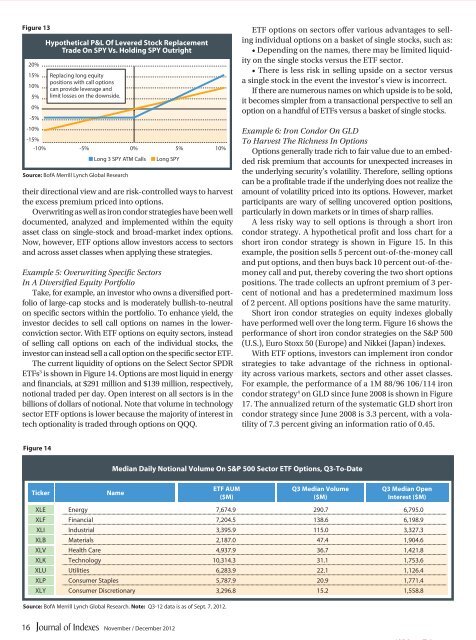Download complete issue - IndexUniverse.com
Download complete issue - IndexUniverse.com
Download complete issue - IndexUniverse.com
Create successful ePaper yourself
Turn your PDF publications into a flip-book with our unique Google optimized e-Paper software.
Figure 13<br />
20%<br />
15%<br />
10%<br />
5%<br />
0%<br />
-5%<br />
-10%<br />
-15%<br />
Hypothetical P&L Of Levered Stock Replacement<br />
Trade On SPY Vs. Holding SPY Outright<br />
Replacing long equity<br />
positions with call options<br />
can provide leverage and<br />
limit losses on the downside.<br />
-10% -5% 0% 5% 10%<br />
Source: BofA Merrill Lynch Global Research<br />
■ Long 3 SPY ATM Calls ■ Long SPY<br />
their directional view and are risk-controlled ways to harvest<br />
the excess premium priced into options.<br />
Overwriting as well as iron condor strategies have been well<br />
documented, analyzed and implemented within the equity<br />
asset class on single-stock and broad-market index options.<br />
Now, however, ETF options allow investors access to sectors<br />
and across asset classes when applying these strategies.<br />
Example 5: Overwriting Specific Sectors<br />
In A Diversified Equity Portfolio<br />
Take, for example, an investor who owns a diversified portfolio<br />
of large-cap stocks and is moderately bullish-to-neutral<br />
on specific sectors within the portfolio. To enhance yield, the<br />
investor decides to sell call options on names in the lowerconviction<br />
sector. With ETF options on equity sectors, instead<br />
of selling call options on each of the individual stocks, the<br />
investor can instead sell a call option on the specific sector ETF.<br />
The current liquidity of options on the Select Sector SPDR<br />
ETFs 3 is shown in Figure 14. Options are most liquid in energy<br />
and financials, at $291 million and $139 million, respectively,<br />
notional traded per day. Open interest on all sectors is in the<br />
billions of dollars of notional. Note that volume in technology<br />
sector ETF options is lower because the majority of interest in<br />
tech optionality is traded through options on QQQ.<br />
ETF options on sectors offer various advantages to selling<br />
individual options on a basket of single stocks, such as:<br />
• Depending on the names, there may be limited liquidity<br />
on the single stocks versus the ETF sector.<br />
• There is less risk in selling upside on a sector versus<br />
a single stock in the event the investor’s view is incorrect.<br />
If there are numerous names on which upside is to be sold,<br />
it be<strong>com</strong>es simpler from a transactional perspective to sell an<br />
option on a handful of ETFs versus a basket of single stocks.<br />
Example 6: Iron Condor On GLD<br />
To Harvest The Richness In Options<br />
Options generally trade rich to fair value due to an embedded<br />
risk premium that accounts for unexpected increases in<br />
the underlying security’s volatility. Therefore, selling options<br />
can be a profitable trade if the underlying does not realize the<br />
amount of volatility priced into its options. However, market<br />
participants are wary of selling uncovered option positions,<br />
particularly in down markets or in times of sharp rallies.<br />
A less risky way to sell options is through a short iron<br />
condor strategy. A hypothetical profit and loss chart for a<br />
short iron condor strategy is shown in Figure 15. In this<br />
example, the position sells 5 percent out-of-the-money call<br />
and put options, and then buys back 10 percent out-of-themoney<br />
call and put, thereby covering the two short options<br />
positions. The trade collects an upfront premium of 3 percent<br />
of notional and has a predetermined maximum loss<br />
of 2 percent. All options positions have the same maturity.<br />
Short iron condor strategies on equity indexes globally<br />
have performed well over the long term. Figure 16 shows the<br />
performance of short iron condor strategies on the S&P 500<br />
(U.S.), Euro Stoxx 50 (Europe) and Nikkei (Japan) indexes.<br />
With ETF options, investors can implement iron condor<br />
strategies to take advantage of the richness in optionality<br />
across various markets, sectors and other asset classes.<br />
For example, the performance of a 1M 88/96 106/114 iron<br />
condor strategy 4 on GLD since June 2008 is shown in Figure<br />
17. The annualized return of the systematic GLD short iron<br />
condor strategy since June 2008 is 3.3 percent, with a volatility<br />
of 7.3 percent giving an information ratio of 0.45.<br />
Figure 14<br />
Median Daily Notional Volume On S&P 500 Sector ETF Options, Q3-To-Date<br />
Ticker<br />
Name<br />
ETF AUM<br />
($M)<br />
Q3 Median Volume<br />
($M)<br />
Q3 Median Open<br />
Interest ($M)<br />
XLE Energy 7,674.9 290.7 6,795.0<br />
XLF Financial 7,204.5 138.6 6,198.9<br />
XLI Industrial 3,395.9 115.0 3,327.3<br />
XLB Materials 2,187.0 47.4 1,904.6<br />
XLV Health Care 4,937.9 36.7 1,421.8<br />
XLK Technology 10,314.3 31.1 1,753.6<br />
XLU Utilities 6,283.9 22.1 1,126.4<br />
XLP Consumer Staples 5,787.9 20.9 1,771.4<br />
XLY Consumer Discretionary 3,296.8 15.2 1,558.8<br />
Source: BofA Merrill Lynch Global Research. Note: Q3-12 data is as of Sept. 7, 2012.<br />
16<br />
November / December 2012

















